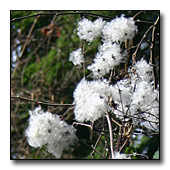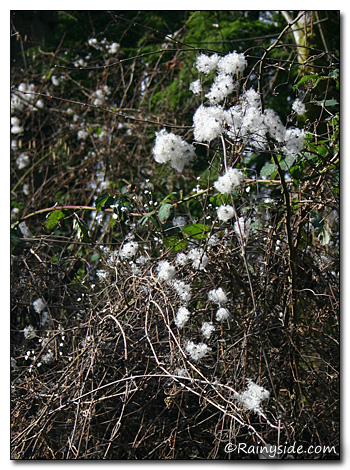
Clematis vitalba
by Mark N. McCann

This non-native invasive species is not the fancy Clematis found in catalogues or seen gracing small lattice work in a well-tended garden. This species, Clematis vitalba, is the other plant (see: English ivy) seen in feral sections of urban woods, engulfing trees, creating an odd, single species, desert of green. The sheer bulk of mature plants will either pull down the host tree, if given time, or kill it by shading it out.
Clematis produces a wispy white seed pod, and the seeds are borne upon the slightest breeze during the late winter, spreading this menace far and wide. The rapid growth of this species makes it as dangerous as ivy, though it is not as widespread. C. vitalba was probably introduced into the rainy side from a single plant in the Puget Sound area, but at this time is mainly found in Washington and Oregon.
Literature often claims traveler’s joy will grow 20 feet per year; however, this may be a gross understatement. It may grow as much as 50 feet per year in some locations and prefers to climb to the highest point in a tree before it spreads out into the limbs.
It has a growth habit similar to ivy, the major difference being the spread of wind borne seeds, while ivy produces a waxy dark berry spread by fauna. traveler’s joy seeds can be carried far on the gossamer thin cottony hairs that surround the pods.
There are also several native species of clematis—C. columbiana being the most common. The difference between native and non-natives can be found in the leaf shape and the color of the flowers.
Identification
The native clematis is either a simple, toothed, heart-shaped or deeply incised, heart-shaped leaf. Somewhere in between is the three-lobed leaf of the traveler’s joy. But the flowers are the dead give-away. C. vitalba has a white or pale yellow flower (alba in Latin relates to the color white), while native species all produce a darker color of either blue, reddish or brownish-purple. The native species are “mostly” climbers or are creepers, while the C. vitalba is an “aggressive” climber. The difference between climbers and creepers is primarily in the stems. An aggressive climber will send out grasping tendrils that will burrow into the host surface, allowing the plant to cling tenaciously (i.e. ivy and traveler’s joy use modified petioles that embed into the host). Often species called “mostly” climbers wrap tendrils around host stems to hold onto a surface, like members of the pea family. The creepers normally have a vining or leggy growth habit that may engulf low objects but has no mechanism that enables it to climb.
These species are all deciduous and the best time to take them out is during the plant’s dormancy period. This plant also carries a “perfect flower.” These contain both male and female parts (dioecious), making it capable of self-pollination.
Removal
The first step in the removal of traveler’s joy requires cutting the plant’s stems above the ground. It is important to make sure the space between the two pieces is large enough to prevent the stem from reattaching itself to the root. Stems can reroot if left in contact with the ground for a long period of time, so periodically move any portions of the plant left in situ. Do not tug on the stems still in the trees. Gravity never sleeps! Pulling on the stem might bring down more than you can handle (all the stem, host branches, or possibly the entire tree).
Digging out the roots of the traveler’s joy is surprisingly easy, but these roots may extend for a long way. Often the roots will be a tangle of overlapping coils and may even come from a distant plant. After that task has been accomplished, a gardener will need to be on the look out for the seedlings that may pop up.
Traveler’s joy is an insidious pest because it readily reproduces vegetatively and by wind cast seeds. The vine-like growth habit spreads myriad possibilities of reproduction over a large area. If a neighbor has an untended C. vitalba, a gardener may find themselves cleaning up their neighbor’s mess.
Because the root’s run shallow, simple “pull and pile” is the best method to kill C. vitalba. Some sources suggest bagging all removed sections of the plant, for an off-site disposal, or burning on-site. Burning adds to the air pollution and may attract unwanted attention from authorities who carry weapons. Therefore, burning should be avoided. Simply moving the pile periodically, or placing the debris on an impervious surface until it has died and begins to decompose, may be all that is needed.
Alternatives
The number of clematis species that are not invasive is large. If C. vitalba is used if you need screening, pick any number of ornamental species found most any place, from Fred Meyers to upscale catalogues.
Native alternatives are relatively few.
Honeysuckle (Lonicera ciliosa) is a wide-spread climbing native, but may be difficult to find in a nursery. It has a bright orange, trumpet shaped flower, and the plant can reach a height of 15 feet or taller. If you are fortunate enough to have one already, they can be easily propagated from cuttings. In the wild, it grows well as long as it has reasonable drainage. A similar native species is the L. hispidula, which is a creeper with a flower that is pink or yellow with pink highlights.
Wildlife Habitat
Hummingbirds will be attracted to both the honeysuckles while they are in bloom. The berries are eaten by birds, though they are unpalatable and possibly poisonous to humans.
Mark N. McCann is currently working on a book about Green Space and Stream Stewardship within the Vancouver-Seattle-Portland-Eugene (VSPE) Corridor. Based on his five years of experience removing invasive species, and replanting and propagating natives species within the Tryon Creek State Natural Area (TCSNA) as a member of the Adopt-A-Plot program. He has been a Citizen Member of the Tryon Creek Watershed Council, Friends of Tryon Creek and presently is a volunteer at Berry Botanic Garden, specifically in the Native Plant’s Trail and in the Propagation Department.
Photographs by Debbie Teashon
Co-author Debbie Teashon's book is now available!

Gardening for the Homebrewer: Grow and Process Plants for Making Beer, Wine, Gruit, Cider, Perry, and More
Copyright Notice | Home | Search | Pest Watch

